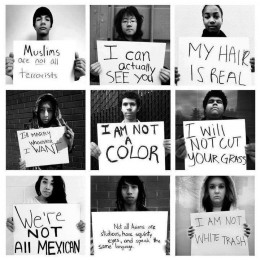#SolutionsMonday: Destabilizing Stereotypes
By Isaac Butler
Last week’s post focused on individuation. Individuation first got our attention as it was included as part of really fascinating work by Patricia Devine titled Breaking the Prejudice Habit and a study she authored titled Long-Term reduction in implicit race bias: A prejudice habit-breaking intervention. In these, she lays out a variety of different strategies for reducing bias and then tests them to see whether they actually work. The good news: they do.
We devoted a whole post to individuation last week because we feel it’s a vital tool for combating bias. Devine lays out several others:
Stereotype replacement—I’m a Jew, so let’s start use an example based on a stereotype of my people. Let’s say you’re talking to a friend who is Jewish and the subject of money comes up, and, all of a sudden, you realize that you are responding to your Jewish friend assuming he’s (a) rich and (b) greedy. What should you do? Stereotype replacement is a possible response. First, recognize that the response you’re having is based on stereotypes, not reality. Next, you label this response stereotypical and reflect on why you had this response. Where did this idea or these assumptions about your friend come from? This creates a process whereby we can consider how to avoid biased responses and what an unbiased response might look like. A similar process can be used with societal stereotyping, including representations we see in the media.
Counter-stereotypic imaging—Stereotypes are really a series of images and ideas we have about people in our mind. One way to beat back stereotypes is to spend time thinking about or imagining people who don’t conform to those stereotypes. Let’s take stereotypes about African American intelligence as our example here. There are many stereotypes in our culture that black people are less intelligent than other people of other races. We can help disrupt these by thinking about examples of black people who are smart. These can be real life friends and family, famous people, fictional characters or even imagined/invented people. Counter-stereotypic imaging isn’t a silver bullet, but it is powerful, and it’s one of the main reasons why diversity, both in real life and in our arts and entertainment, is so important.
Perspective taking—This is exactly what it sounds like. When we imagine ourselves to be a member of a stereotyped group, it increases psychological closenesss to that group, lessening the impact of automatic stereotype-based evaluations.
Increasing opportunities for contact—Again, we return to how important diversity and integration are. By increasing opportunities for “intergroup contact” (in short: hanging out with people who don’t belong to your identity group), particularly when those instances of contact are facilitated and positive, can ameliorate implicit bias through a variety of mechanisms. It helps support individuation and counter-stereotypic imaging, and can, over time, shift how we feel about people different from us.
We discuss all of these in our report The Science of Equality, Vol. 1. Patricia Devine also has her own site dedicated to these and other methods.

